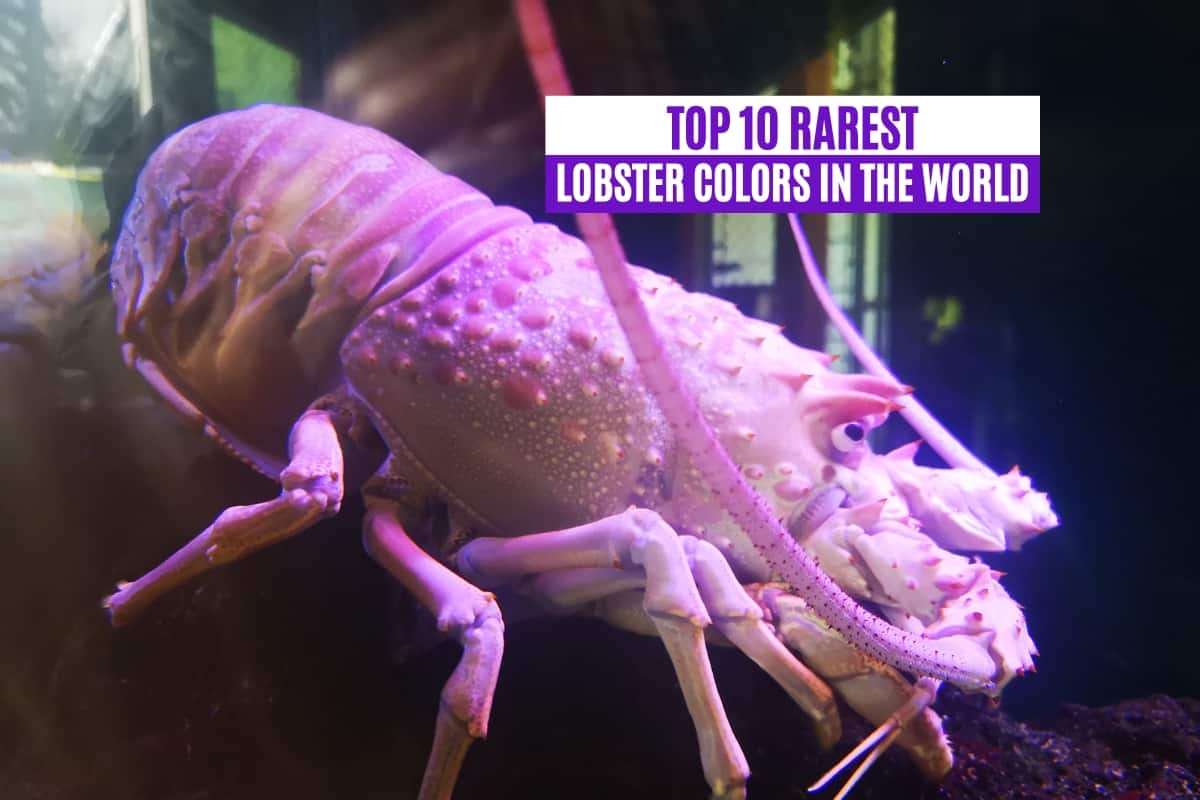Most people assume that lobsters are naturally red. But most lobsters are a muddy brown color and only turn red after being boiled! Still, these crustaceans come in a wide variety of hues, some of which are rarer than others.
The rarest lobster color is white, also called albino. White lobsters lack pigment in their shells due to genetic mutations, and the chances of finding an albino lobster are about one in 100 million. Other rare lobsters can be blue, split-colored (Halloween), calico, or cotton candy.
Whether you’re looking to dine on a rare lobster or hoping to catch a valuable specimen, you’ll want to familiarize yourself with the rarest lobster colors in the world.
Here Are the Top 10 Rarest Lobster Colors in the World:
- White Lobster
- Cotton Candy Lobster
- Halloween Lobster
- Calico Lobster
- Orange Lobster
- Yellow Lobster
- Red Lobster
- Blue Lobster
- Green Lobster
- Dark Brown Lobster
10. Dark Brown Lobster
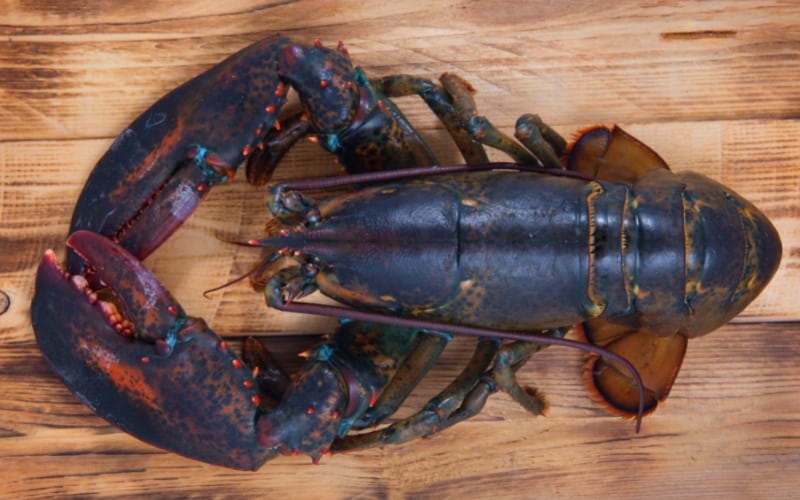
If you’ve ever visited the seafood section of your local grocery store, there’s a good chance that you’ve seen live lobsters. These freshly-caught crustaceans in the grocery store tank are almost always a muddy brown color.
That’s because dark brown is the most common lobster coloration, and for good reason. Like all other wild animals, particularly marine animals, lobsters rely on their coloration for survival.
Lobsters live on the ocean floor and around rocky coastlines. As such, having dark brownish exteriors allows them to blend into their surroundings.
This natural camouflaging makes it harder for predators (like seals and crabs) to detect them. Lobsters that cannot camouflage themselves from predators (i.e., lobsters that are bright, eye-catching colors) often become lunch or dinner, thus preventing them from living long enough to produce offspring.
In short, most lobsters are dark brown because they’re the most capable of living long enough to reproduce. It’s survival of the fittest (or dark brownish)!
Why Is It So Rare?
Most lobsters are mud-brown, so dark brown lobsters aren’t rare. Black lobsters (European lobsters) are equally common.
That said, if you ever find a lobster that’s any other color, you’ve got your hands on a rare crustacean.
9. Green Lobster
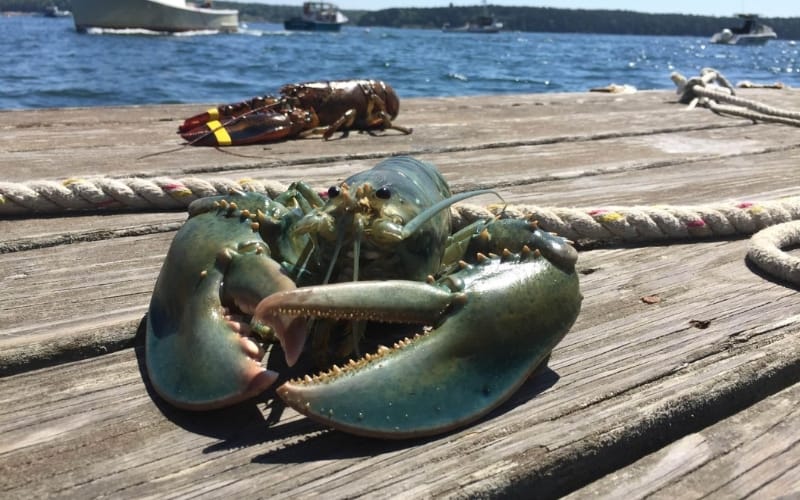
Brown lobsters are exceptionally common, and olive green lobsters aren’t far behind. After all, being a dark green color helps lobsters blend into algae growth, helping them avoid predators.
Still, true green lobsters are far less common than their dark brown counterparts.
Apart from genetics, the main thing influencing a lobster’s coloration is diet. Jade-green lobsters may get their coloration from consuming lots of algae or chlorophyll-rich plant matter.
Because true green lobsters are so rare, more research is needed to confirm the cause of their distinct coloration. One of the only recorded instances of a green lobster dates back to 2016, when a fisherman in Harpswell, Maine, caught one.
This lobster was sent to the Maine State Aquarium for further investigation and study.
Why Is It So Rare?
Maine is known for its fresh-caught seafood, particularly its lobster. But locals were shocked when a Maine fisherman pulled a green lobster out of the water in 2016.
If people who’ve spent their whole lives around these crustaceans report never having seen a green lobster before, you know you’ve hit the rarity jackpot. Unfortunately, there’s little information about why some lobsters might appear green.
8. Blue Lobster
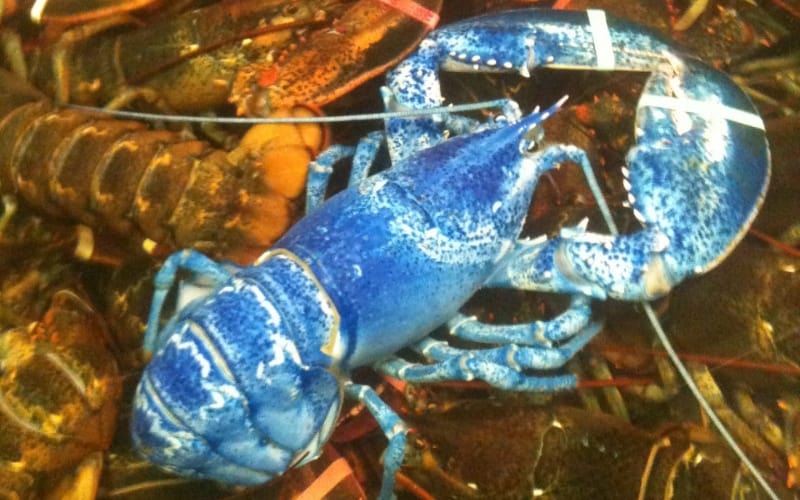
Like many of the world’s most expensive birds, some of the rarest and most valuable lobsters are a beautiful blue hue, much like a sapphire.
Unlike other lobsters that exhibit unusual or rare colors, there’s been a decent amount of research into blue lobsters. This might be because the chances of finding a blue lobster are slightly higher than the chances of finding a pastel, white, or orange lobster.
But what are those chances? About one in two million!
Still, the prevailing theory concerning this lobster’s unique royal blue shell coloration is that it comes down to diet. These lobsters might be blue because they don’t consume enough foods containing astaxanthin (like shellfish and crabs).
This red chemical helps lobsters generate a red pigment that gives their shells a typical brownish-red hue. Lobsters that don’t consume enough of this pigment or have a genetic mutation that mutes this pigment can appear blue.
Why Is It So Rare?
As with any other animal, genetic mutations occur somewhat randomly in lobsters. As such, the chance of a lobster developing the specific genetic mutation that would cause them to lose red pigmentation is somewhat rare.
Equally, most lobsters have access to prey foods that contain the red astaxanthin chemical. But some blue lobsters get their shell color because their diets don’t consist of astaxanthin-containing foods. This is unusual, making blue lobsters just as unlikely.
7. Red Lobster
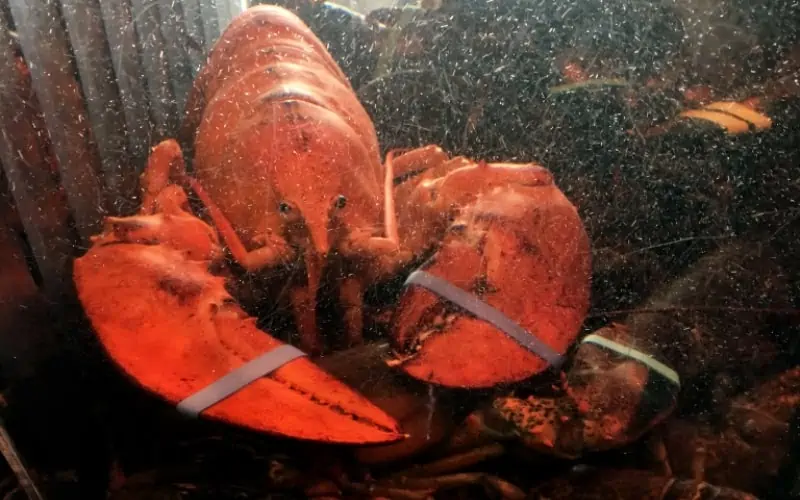
Now, if you enjoy dining on lobster, you might think that red lobsters are exceptionally common. After all, pretty much all lobsters served at restaurants are a bright red color!
However, lobsters generally only turn red after they’re cooked. So catching a live red lobster is a bit like winning the lottery. The chances of pulling up one of these lobsters from the ocean are about one in 10 million.
Why Is It So Rare?
Lobsters have plenty of red in their shells, but this hue combines yellows and blues to create a murky brown color.
But when lobsters have a genetic mutation that doesn’t “wrap” the red pigment, hiding it and binding it with other pigments, it can come to the surface and turn lobsters a bright red color. As with other rare-colored lobsters, this genetic mutation is entirely random, making the chances of catching a naturally red lobster quite low.
6. Yellow Lobster
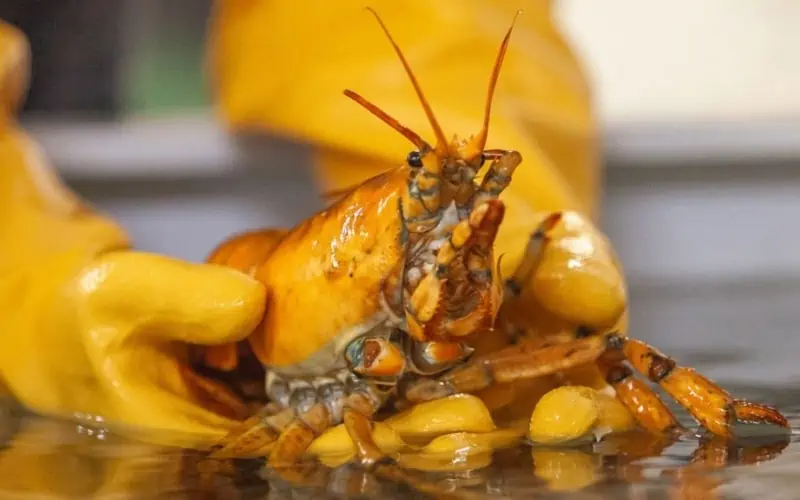
Bright yellow lobsters rarely occur in nature, and it’s not challenging to understand why. Lobster shells are generally able to blend into the surrounding environment, and the bottom of the ocean floor isn’t a bright canary yellow!
As a result, yellow lobsters become easy targets for hungry predators. But in 2021, an angler named Marley Babb caught a yellow lobster in St. George, Maine. This lobster, named Banana, was sent to the University of New England’s Marine Science Center for further research.
The chances of catching one of these lobsters are only one in 30 million!
Why Is It So Rare?
The precise combination of pigments, proteins, and genetic mutations that result in a yellow lobster makes these crustaceans very rare. Additionally, most yellow lobsters quickly fall prey to seals, flounder, and other lobsters. So discovering one is like finding a bright yellow needle in a pile of dried hay.
5. Orange Lobster
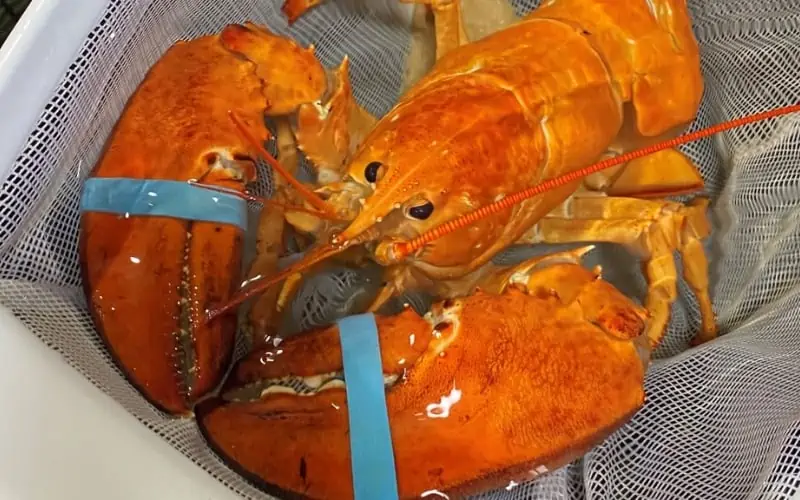
In 2022, employees at a Red Lobster restaurant in South Carolina discovered that one of the lobsters the store had received was bright orange instead of dark brown.
This lobster immediately caught the eye of management, who decided against cooking and serving the strangely colored crustacean. They even gave the lobster a name; Cheddar!
Notably, orange lobsters are just as rare as calico lobsters. The chances of finding one are about one in 30 million. The one discovered by Red Lobster staff is now living in captivity at the Ripley’s Aquarium of Myrtle Beach.
Why Is It So Rare?
Orange lobsters get their coloration due to genetic mutations. These mutations make them easy prey for hungry marine predators, so many bright orange lobsters don’t survive into adulthood. Consequently, the chances of finding an orange lobster are quite low.
4. Calico Lobster
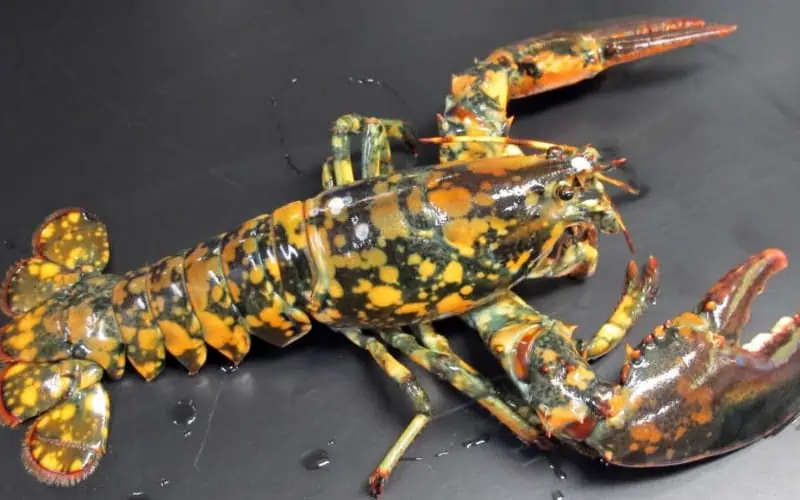
Some of the most expensive goldfish have multicolored scales. But most lobsters are a single, solid color. Still, there are exceptions, including the calico lobster.
Like calico cats, calico lobsters are a mix of yellow, black, and brown. These colors are randomly dispersed across the lobster’s shell, resulting in a freckled appearance that makes them immediately stand out from their dark brown counterparts.
As with orange lobsters, the chances of discovering a calico lobster are about one in 30 million.
Why Is It So Rare?
Calico lobsters are easier to spot than common brown or black lobsters. They can’t blend in with their surroundings like other lobsters, so they’re typically predated by hungry marine animals, rarely surviving into adulthood.
In fact, rare coloration is incredibly dangerous for lobsters. This lack of camouflage is one of the major reasons why lobsters with unusual shell colors are so rare.
3. Halloween Lobster
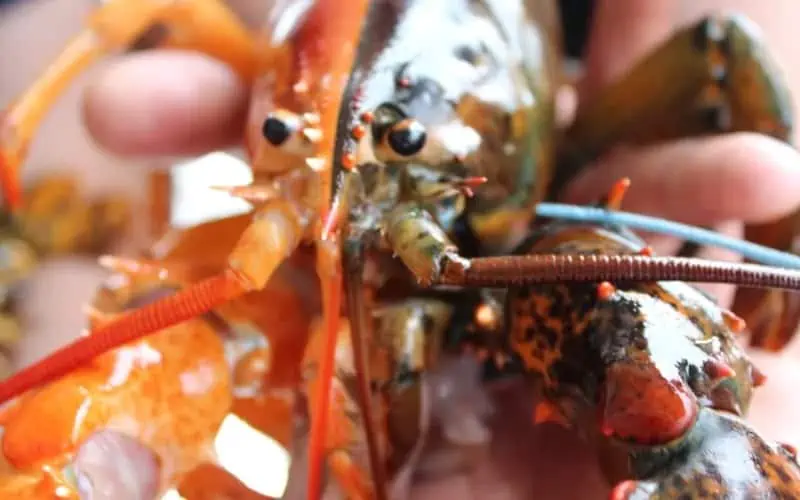
Halloween lobsters aren’t particularly frightening, but they are some of the most uniquely colored lobsters in the world.
These lobsters are brown and orange (typically Halloween colors), but unlike calico lobsters, these colors are split cleanly down the middle of the lobster. So one side is black or dark brown, and the other is a rich orange hue.
This distinct two-tone coloration is a combination of the most common lobster coloration (dark brown) and one of the rarest (orange). The chances of finding one of these festive crustaceans are only about one in 50 million!
Why Is It So Rare?
The split coloration of the Halloween lobster is likely the result of either a genetic mutation or hermaphroditism, potentially both.
Essentially, these two-tone lobsters might form when two fertilized lobster eggs combine into a single egg or when an egg experiences a genetic split while developing.
Like giving birth to identical twins, the chances of this happening are quite low, making Halloween lobsters exceptionally rare.
2. Cotton Candy Lobster
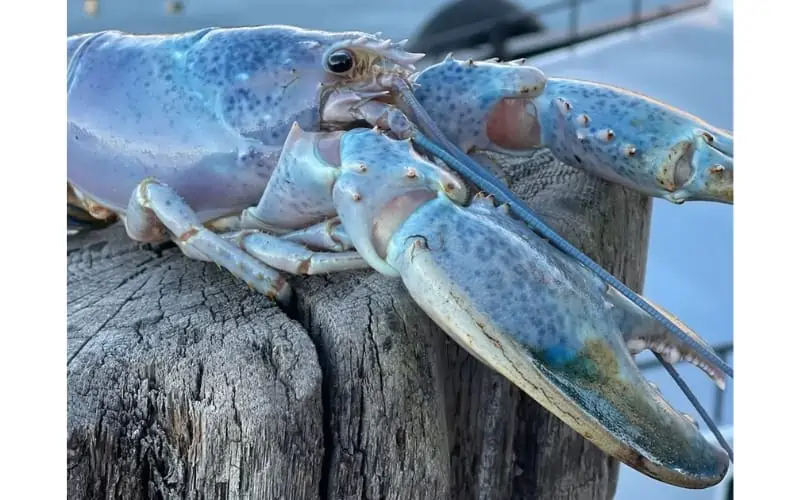
Cotton candy lobster might not sound very appealing, but this term refers to coloration, not taste.
Also called pastel or “moon mist,” this coloration is a combination of light blues, purples, and pinks. The chances of discovering a lobster with this coloration are about one in 50 million (though some have guessed the chances could be as low as one in 100 million).
Like blue lobsters, the cotton candy lobster’s coloration might stem from an unusual diet. However, genetic mutations might also be responsible for giving this crustacean its eye-catching pastel hue.
Why Is It So Rare?
These multicolor lobsters rarely occur in nature, and there are two prevailing theories about how these lobsters turn a speckled blue-pink color.
Firstly, cotton candy lobsters might live in areas where crab and shrimp populations are scarce. Instead of consuming these typical foods, they might rely on eating small fish.
An American lobster’s dark brown (sometimes reddish) coloration comes from astaxanthin, a rich red carotenoid. This chemical is derived from crustaceans and shellfish. So, when a lobster doesn’t eat enough creatures that contain astaxanthin, it can become unusually colored.
A lack of astaxanthin is the primary cause of blue lobsters. But cotton candy lobsters look different from blue lobsters. Consequently, these unique creatures might also have genetic mutations that help their shells turn a bright pastel color.
The chances of catching a cotton candy lobster are about the same as finding a white lobster. As such, both could be considered the rarest lobster colors.
1. White Lobster
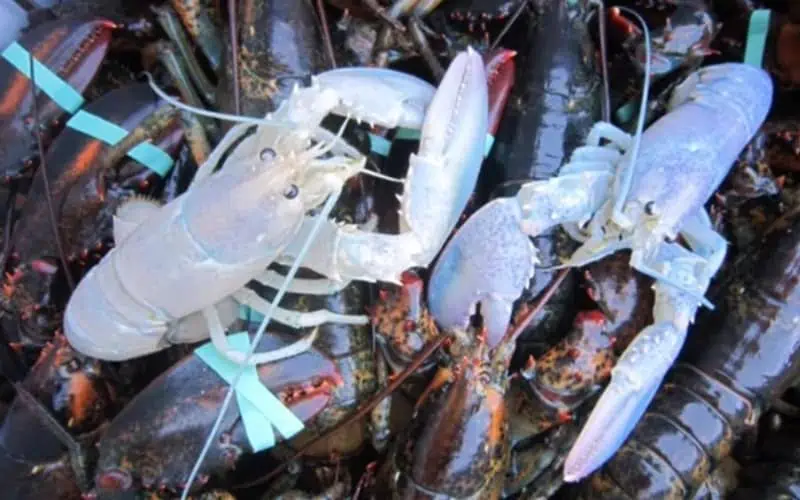
The rarest lobster color is white (also called albino or ghost). Finding a white lobster is highly unlikely, and the odds of catching one are about one in 100 million.
That said, in 2014, two white lobsters were caught in New England within the same week! But anglers only catch a handful of these pearl-colored iridescent crustaceans each year, if that.
Most ghost lobsters are donated to aquariums or universities. A lucky few, like one caught in Guernsey in 2022, are returned to the ocean.
You could spend a lifetime catching lobsters without seeing one of these unique animals.
After all, albino lobsters get their shiny white shells from genetic mutations prohibiting pigmentation. These mutations are often random, with few white lobsters living long enough to produce similarly-colored offspring.
Why Is It So Rare?
White lobsters lack pigmentation. This absence of coloration makes albino lobsters far easier to spot, making them easy prey. Consequently, few white lobsters survive into adulthood and reproduce.
As such, the chances of passing on the same genetic mutations to offspring are quite low.
Because specific genetic changes are the primary cause of albinism in lobsters (though diet may also play a role), the likelihood of those precise mutations happening again in other lobsters is minimal.
In short, white lobsters are rare because:
- The factors that create them are somewhat random, and
- Most white lobsters don’t live long enough to produce identical offspring
Are Rare Lobsters Expensive?
Unlike the rarest and most expensive betta fish, it’s challenging to gauge the value of a rare lobster that’s an unusual color.
Most lobsters exhibiting rare colors (like the green lobster discovered in 2016) are donated to aquariums. Others, like blue lobsters, are sold to high-end restaurants.
Still, lobster dishes made from blue, orange, calico, and other rare lobsters are often more expensive than meals made from standard brown and black lobsters.
Live lobsters that are uncommon colors can sell online for hundreds of dollars (up to about $500)!
What’s the Rarest Lobster Color in the World?
The rarest lobster color in the world is white (albino). The chances of finding a white lobster are one in 100 million!
Not only is the likelihood of a lobster being an albino exceptionally low, but white lobsters are far easier prey for predatory fish due to their inability to camouflage into the surrounding environment. Rare lobsters can also have blue, cotton candy, calico, split (Halloween), or orange shells.
Check out these related articles to get the scoop on the world’s rarest and most expensive animals!

